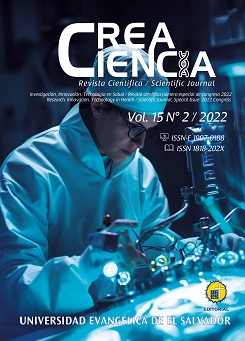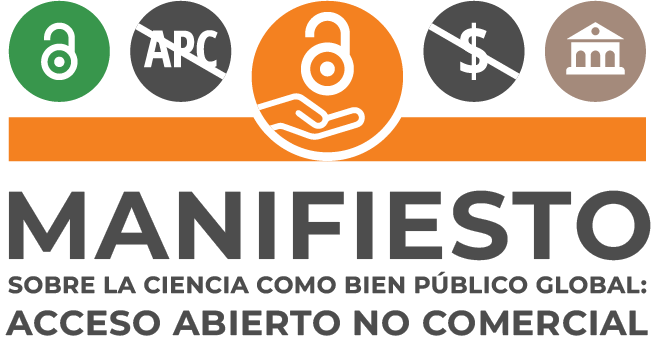Relationship between the dental caries index and nutritional status in children from 5 to 11 years of age, UCSFI San Miguel Tepezontes and Panchimalco, 2019.
DOI:
https://doi.org/10.69789/creaciencia.v15i2.661Abstract
Dental caries is an infectious disease in which modulating factors intervene that allow the presence of said disease in the oral cavity, (1) being a morbidity that affects a large number of people including children and adults, (2,3) especially in the first and last years of life; It is estimated that millions of people are affected by this morbidity worldwide. (4) Dental caries, according to the literature, can affect the nutritional status of an individual due to the orofacial pain caused, generating problems for adequate nutrition due to discomfort when chewing and ingesting food. (5) Likewise, excessive malnutrition can contribute to the prevalence and incidence of dental caries. (6,7) Both types of malnutrition can influence an individual; For example, malnutrition due to excess is characterized by individuals preferentially consuming foods with a high presence of carbohydrates, which are fermented by bacteria in the mouth and thus produce dental caries (6,7); Deficiency malnutrition can affect the individual due to the lack of minerals that make up the dental organ, making it less resistant to acids coming from bacteria; In this way, malnutrition can influence the presence of dental caries in individuals. (5) According to a study in 2017, it is estimated that around 530 million children have dental caries in primary teeth and 2.3 billion people suffer from dental caries in primary teeth. permanent. Dental caries is a very important disease, since the stomatognathic system is essential to perform essential functions in the human being, such as chewing, phonation and aesthetics, which are important for the full development of the human being. (8) According to the World Health Organization, overweight and obesity have reached epidemic figures worldwide and are a major problem in the 21st century, as prevalence has increased at an alarming rate; Likewise, malnutrition has been increasing, making malnutrition a public health problem. (4.9)
References
Sánchez-Pérez L, Sáenz Martínez LP, Molina-Frechero N, Irigoyen-Camacho ME, Alfaro-Moctezuma P. Riesgo a caries. Diagnóstico y sugerencias de tratamiento. Rev ADM [Internet]. 2018 [citado 2020 Sep 11];75(6):340–9. Disponible en:https://www.medigraphic.com/pdfs/adm/od-2018/od186h.pdf
Aquino-Canchari CR, Cuya-Salvatierra NG. Experiencia de caries dental y masa corporal en escolares peruanos. Rev Cubana Estomatol [Internet]. 2018 [citado 2020 Sep 11];55(3):1–9. Disponible en: http://scielo.sld.cu/scielo.php?script=sci_arttext&pid=S0034
&lng=es
Reátegui Alcántara CP. Asociación entre caries dental y estado nutricional en el Perú, 2014 [tesis doctoral]. Perú: Repositorio Institucional Universidad Peruana Cayetano Heredia; 2018. 77 p. Disponible en: https://repositorio.upch.edu.pe/bitstream/handle/20.500.12866/3536/Asociacion_ReateguiAlcantara_Claudia.pdf?sequence=1&isAllowed=y
Organización Mundial de la Salud [Internet]. Organización Mundial de la Salud; © 2020. Malnutrición; 2020 Abr 01 [actualizado 2024 Mar 01; citado 2020 Sep 24]; [aproximadamente 5 p.] Disponible en: https://www.who.int/es/news-room/fact-sheets/detail/malnutrition
González Muñoz M, Adobes Martín M, González de Dios J. Revisión sistemática sobre la caries en niños y adolescentes con obesidad y/o sobrepeso. Nutr Hosp [Internet]. 2013 Sep–Oct [citado 2020 Sep 23];28(5):1372–83. Disponible en: http://www.nutricionhospitalaria.com/pdf/6674.pdf doi: 10.3305/nh.2013.28.5.6674
Quiñones Ybarría ME, Pérez Pérez L, Ferro Benítez PP, Martínez Canalejo H, Santana Porbén S. Estado de salud bucal: su relación con el estado nutricional en niños de 2 a 5 años. Rev Cubana Estomatol [Internet]. 2008 Jun [citado 2020 Sep 23];45(2):22–31. Disponible en: http://scielo.sld.cu/scielo.php?script=sci_arttext&pid=S0034-75072008000200004
Marimón Torres ME, Corbo Rodríguez MT, Rodríguez Rodríguez A, Torres Rivero IM. Seguridad alimentaria y nutricional vinculada a la asignatura Médico Bucal I en Odontología. Revista de Ciencias Médicas de Pinar del Río [Internet]. 2015 [citado 2020 Sep 11];19(1):113–25. Disponible en: http://scielo.sld.cu/scielo.php?script=sci_arttext&pid=S1561-31942015000100014
GBD 2017 Disease and Injury Incidence and Prevalence Collaborators. Global, regional, and national incidence, prevalence, and years lived with disability for 354 diseases and injuries for 195 countries and territories, 1990-2017: a systematic analysis for the Global Burden of Disease Study 2017. Lancet. 2018 Nov 10 [citado 2020 Nov 25];392(10159):1789–1858. doi: 10.1016/S0140-6736(18)32279–7. Errata en: Lancet. 2019 Jun 22;393(10190):e44. Disponible en: https://www.thelancet.com/journals/lancet/article/PIIS0140-6736(18)322797/fulltext
Ministerio de Salud de El Salvador. Diagnóstico nacional de salud bucal [Internet]. El Salvador: Ministerio de Salud, Viceministerio de Políticas de Salud, Dirección de Regulación y Legislación en Salud, Unidad de Atención Integral e Integrada a la Salud Bucal; 2012 Jun [citado 2020 Nov 25]. 45 p. Disponible en https://asp.salud.gob.sv/regulacion/pdf/otrosdoc/diagnostico_nacional_salud_bucal.pdf
Downloads
Published
Issue
Section
License
Copyright (c) 2022 Universidad Evangélica de El Salvador

This work is licensed under a Creative Commons Attribution-NonCommercial-ShareAlike 4.0 International License.
Los artículos de Crea Ciencia están publicados en acceso abierto bajo una licencia CC BY-NC-SA 4.0 de la Universidad Evangélica de El Salvador.





















